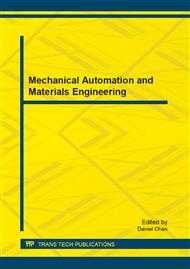[1]
Wang Shutian. Textile Machinery Industry Review and Reflection [J]. Textile Machinery, 2009 (3) : 2-8.
Google Scholar
[2]
Pan Jinzhi, Renrui Ming, Guo Libo, Qi is the wind. Quenching 60Si2Mn microstructure and mechanical properties [J]. Thermal processing, 2010, 39 (22) : 146-148.
Google Scholar
[3]
Zhou Yueqing Zhang Yuanyuan, Cheng Yihan. Induction hardening electromagnetic - thermal coupling field finite element analysis [J]. Heat Treatment of Metals, (2007).
Google Scholar
[4]
T. Palin-Luc,D. Coupard,C. Dumas, P. Bristiel. Simulation of multiaxial fatigue strength of steel component treated by surface induction hardening and comparison with experimental results[J]. International Journal of Fatigue, 2011, 33(8): 1040-1047.
DOI: 10.1016/j.ijfatigue.2011.02.004
Google Scholar
[5]
DAI Qi Xun, Cheng Xiaonong metal organizational control principle [M] Beijing: Chemical Industry Press, 2008: 94 is -124.
Google Scholar
[6]
Yang LI, Yu-peng LU, Chong WANG, Shi-tong LI, Lu-bin CHEN. Phase Stability of Residual Austenite in 60Si2Mn Steels Treated by Quenching and Partitioning[J]. Journal of Iron and Steel Research, 2011, 18(2): 70-74.
DOI: 10.1016/s1006-706x(11)60026-5
Google Scholar
[7]
C. Camurri,C. Carrasco,J. Dille. Residual stress during heat treatment of steel grinding balls[J]. Journal of Materials Processing Technology, 2008, 208(1-3): 450-456.
DOI: 10.1016/j.jmatprotec.2008.01.007
Google Scholar
[8]
CHEN Zai-liang LU Dong-xian CAO Ming-yu FU Hai-feng. Study on Residual Stress and Crack Failure in Metal Heat Treatment[J]. Heat Treatment of Metals, 2007(S1): 40-44.
Google Scholar
[9]
J.R. Cho B.Y. Lee Y.H. Moon C.J. Van Tyne. Investigation of residual stress and post weld heat treatment of multi-pass welds by finite element method and experiments [J]. Journal of Materials Processing Technology, 2004, 155-156: 1690-1695.
DOI: 10.1016/j.jmatprotec.2004.04.325
Google Scholar
[10]
S. Rav,V. Balasubramanian,S. Nemat Nasser. Influences of post weld heat treatment on fatigue life prediction of strength mis-matched HSLA steel welds[J]. International Journal of Fatigue, 2005, 27(5): 547-553.
DOI: 10.1016/j.ijfatigue.2004.09.006
Google Scholar


